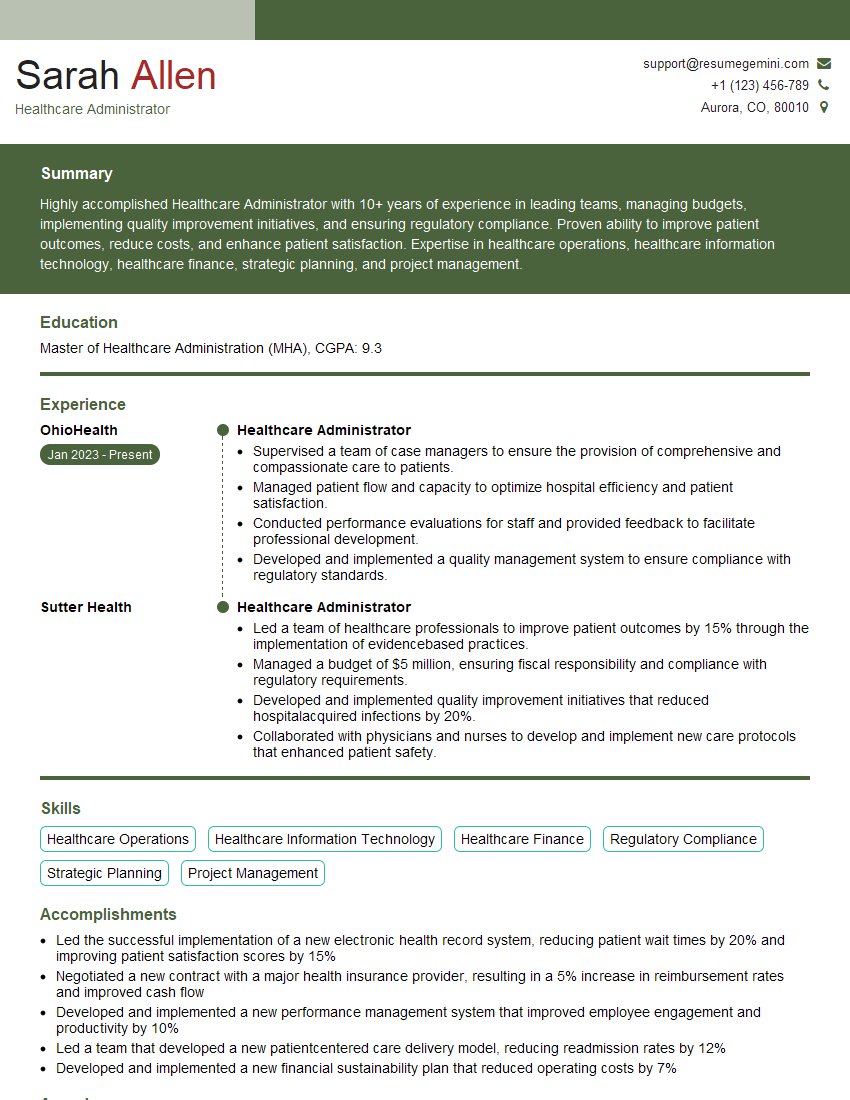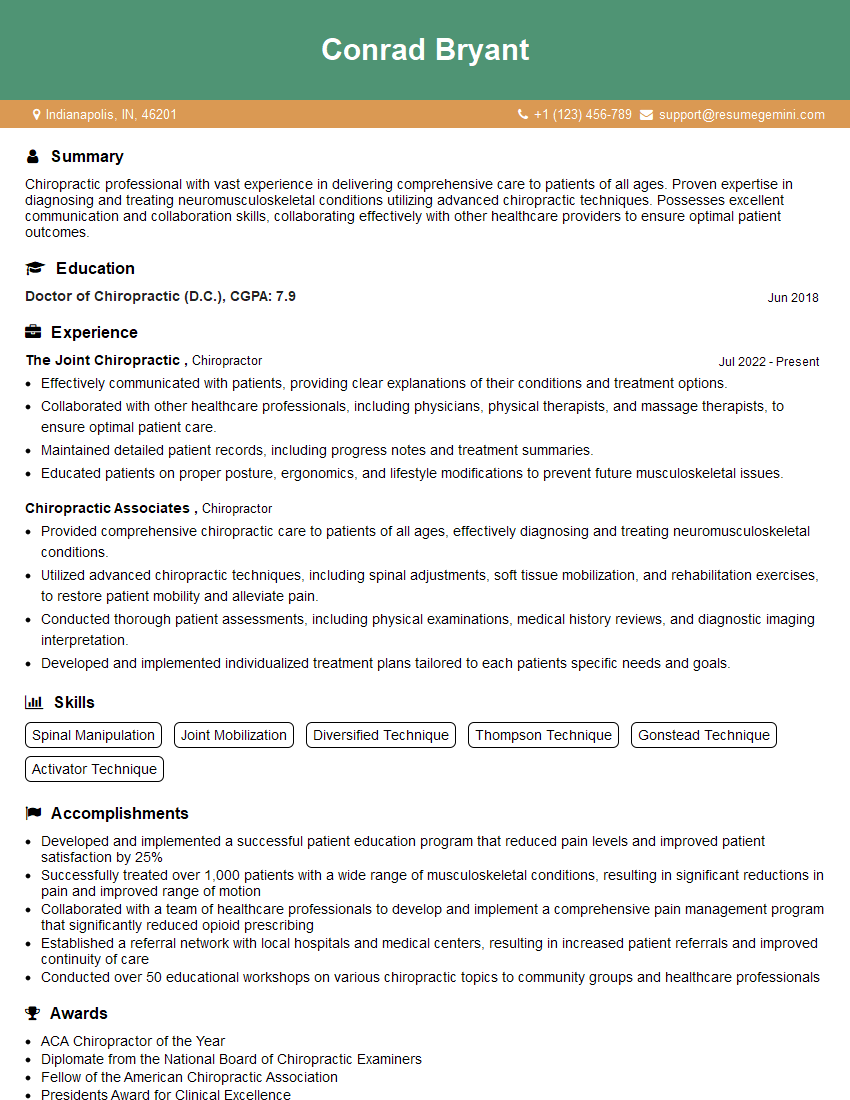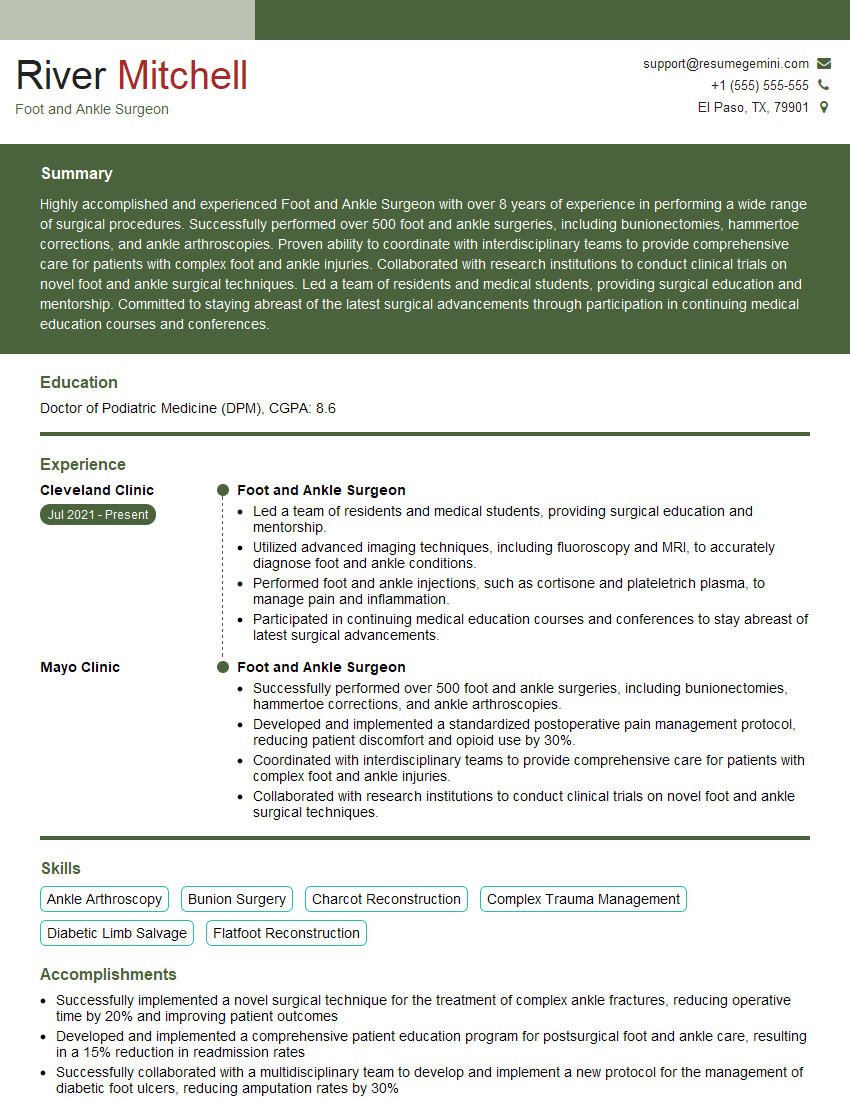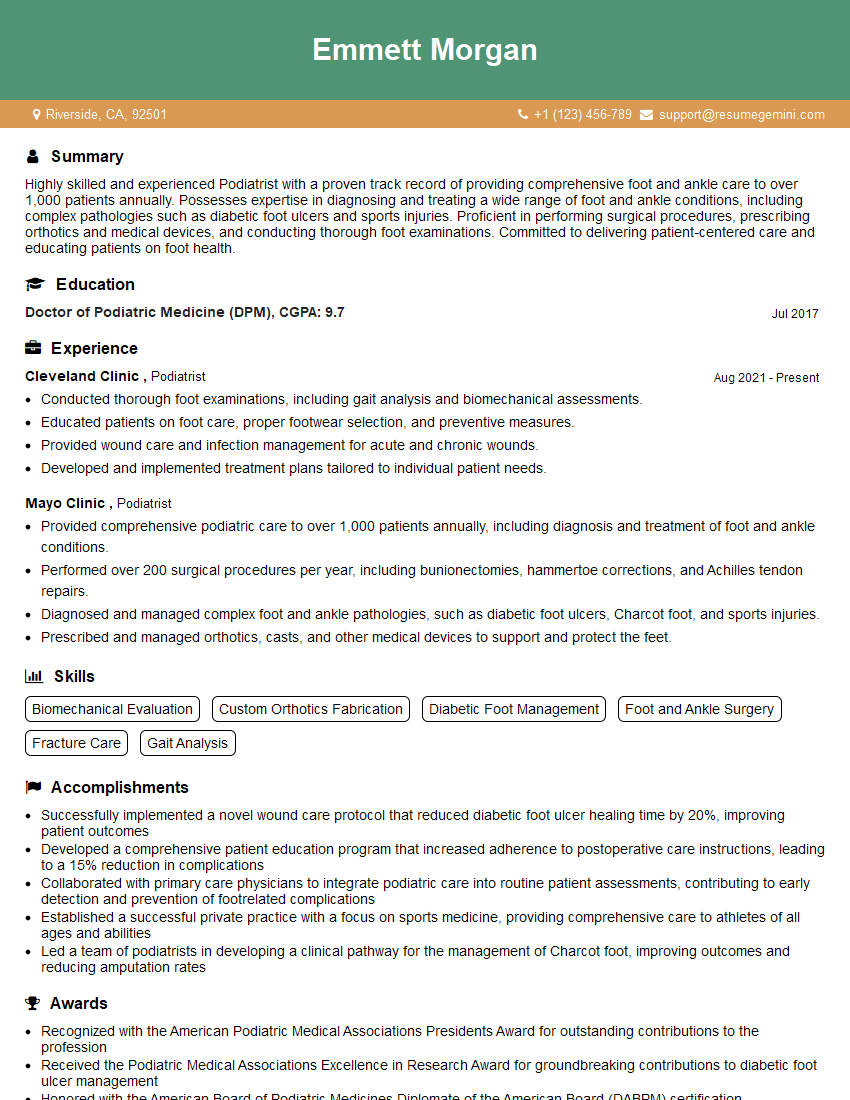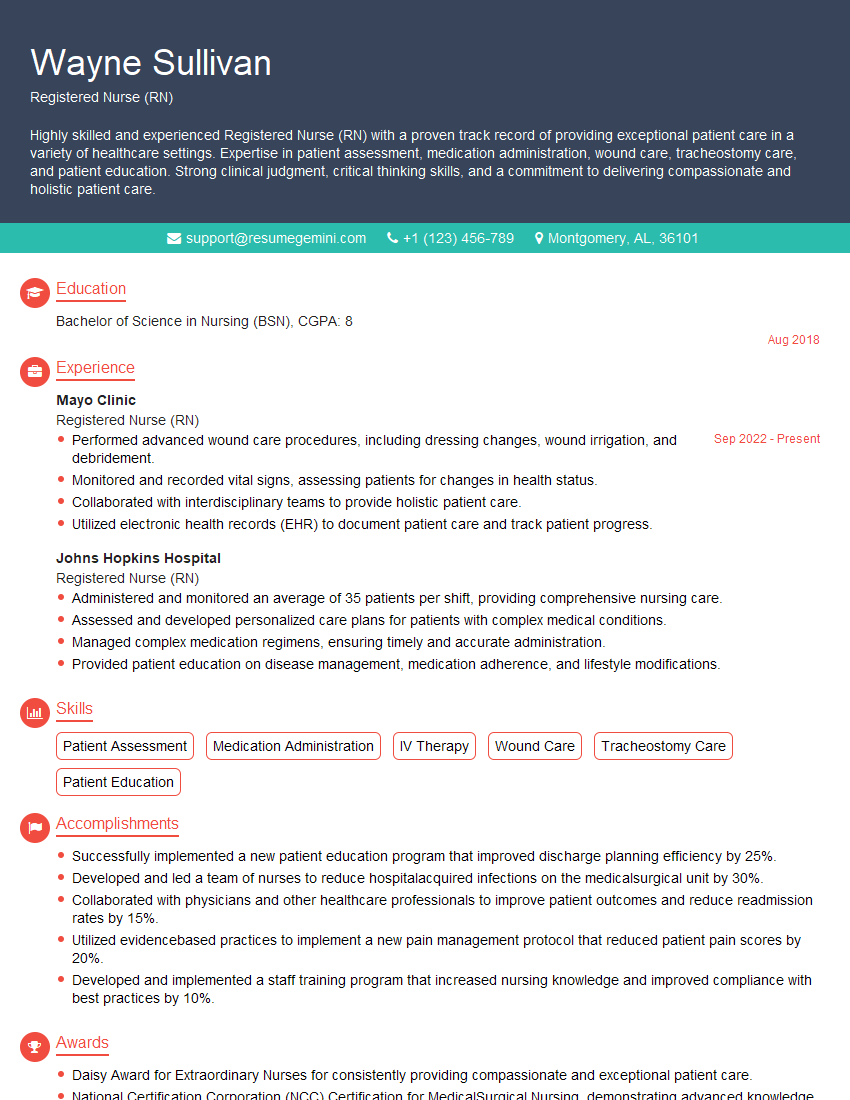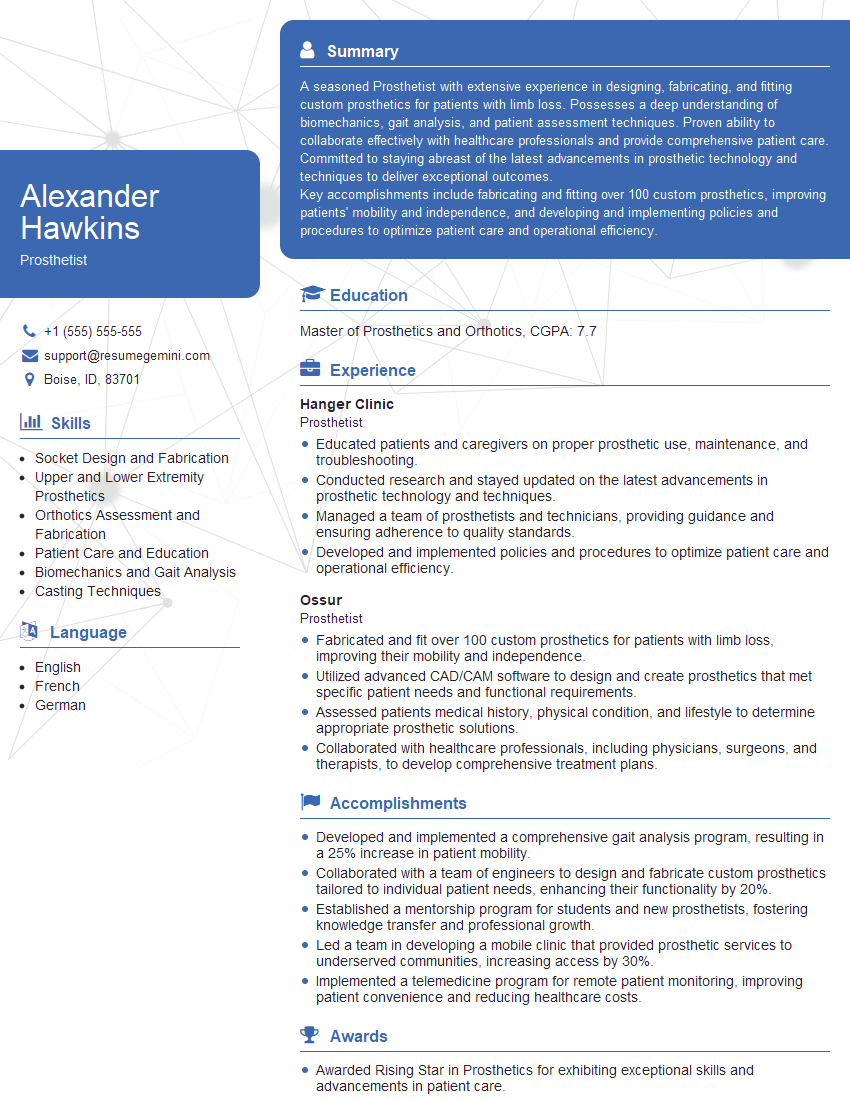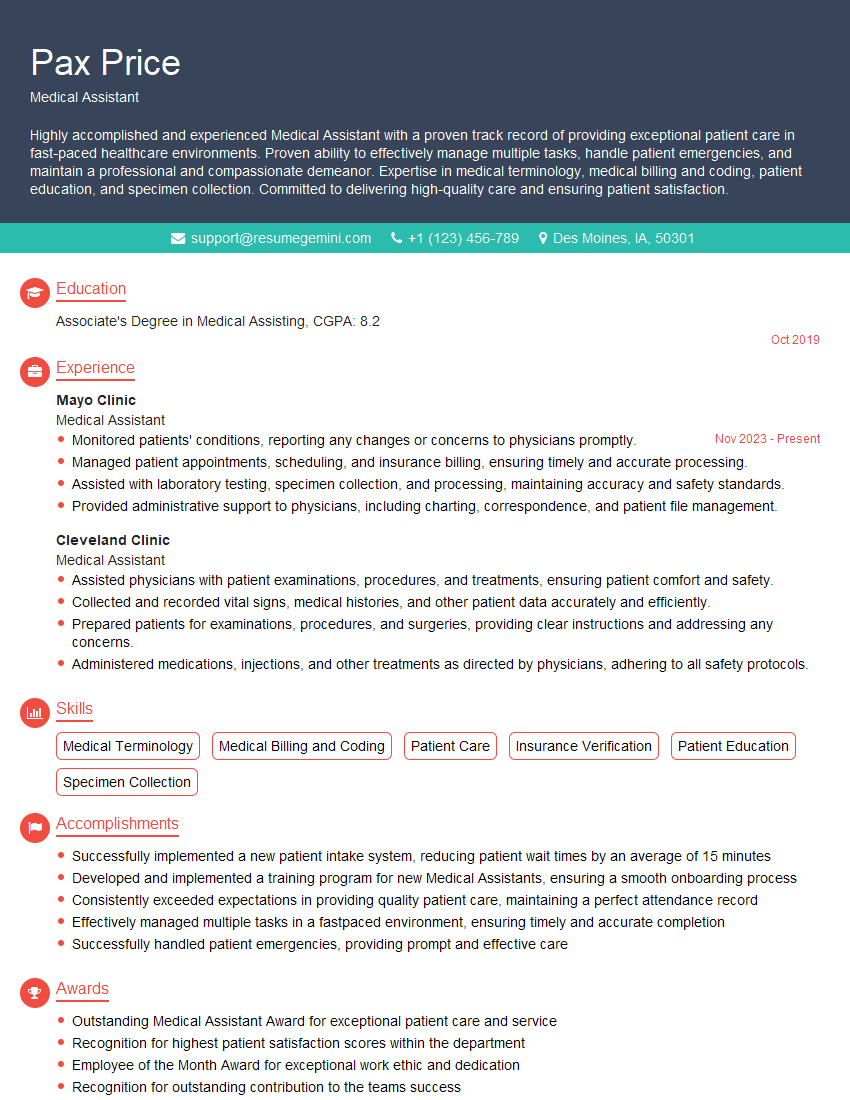Interviews are more than just a Q&A session—they’re a chance to prove your worth. This blog dives into essential Bunions and Hammertoes Treatment interview questions and expert tips to help you align your answers with what hiring managers are looking for. Start preparing to shine!
Questions Asked in Bunions and Hammertoes Treatment Interview
Q 1. Describe the different types of bunions and their typical presentations.
Bunions, or hallux valgus, are deformities at the base of the big toe where the joint becomes enlarged and protrudes. While the most common type involves the big toe angling towards the other toes, there are variations:
- Lateral hallux valgus: The most common type, where the big toe drifts laterally (towards the second toe).
- Medial hallux valgus: Less common, where the big toe deviates medially (towards the midline of the foot).
- Hallux abducto valgus: This describes the combination of abduction (toe moving away from the midline) and valgus (the bone angled away from the midline) deformities, the most common presentation.
- Hallux rigidus: This is not strictly a bunion but often coexists. It involves stiffness and pain in the big toe’s joint, limiting movement.
Typical presentations include a bony bump at the base of the big toe, pain, redness, swelling, and difficulty finding comfortable footwear. The severity can range from mild discomfort to significant pain and functional limitations.
Q 2. Explain the conservative treatment options for bunions, including their limitations.
Conservative bunion treatment aims to manage pain and slow progression, not reverse the deformity. Options include:
- Footwear modifications: Wearing wide, roomy shoes with adequate toe box space to reduce pressure on the bunion is crucial. Avoid high heels and pointed-toe shoes.
- Orthotics: Custom or over-the-counter arch supports and bunion pads can help alleviate pain and improve foot mechanics by distributing weight more evenly.
- Pain medication: Over-the-counter pain relievers like ibuprofen or naproxen can help manage pain and inflammation. In some cases, a doctor may prescribe stronger medications.
- Physical therapy: Exercises to strengthen the muscles surrounding the foot and improve flexibility can help improve alignment and reduce pain. This often involves stretches and strengthening exercises targeting the intrinsic and extrinsic foot muscles.
- Injection therapy: Corticosteroid injections can reduce inflammation in the joint temporarily, providing pain relief.
Limitations: Conservative treatments don’t correct the underlying bony deformity. They primarily address symptoms. If the bunion progresses or causes significant pain despite conservative management, surgery is often necessary.
Q 3. What are the surgical techniques used to correct bunions? Compare and contrast them.
Several surgical techniques correct bunions, each with its advantages and disadvantages:
- Osteotomy: This involves cutting and realigning the bones of the big toe to correct the deformity. Several types exist, including base wedge, closing wedge, and proximal phalangeal osteotomies, each tailored to the specific bunion type and severity.
- Arthrodesis: This is a fusion procedure where the joint is permanently fixed in a correct position. This eliminates movement in the joint, but reduces pain and corrects the bunion deformity. It’s usually reserved for severe osteoarthritis or cases where other procedures have failed.
- Soft tissue procedures: These address the soft tissue components of the bunion deformity, often used alongside bone procedures. They may involve releasing tight ligaments or tendons, which can reduce pain and improve range of motion.
- Cheilectomy: This involves removing the bony prominence of the bunion to reduce pain, rather than realigning the bones. Often done in milder cases
Comparison: Osteotomies are commonly used to correct the deformity, while arthrodesis sacrifices movement for stability. Soft tissue procedures alone are rarely sufficient for significant bunions. The choice depends on the individual’s age, activity level, severity of the deformity, and presence of arthritis.
Q 4. Describe the post-operative care for bunion surgery and potential complications.
Post-operative care for bunion surgery is critical for successful recovery. It typically involves:
- Immobilization: A postoperative shoe or cast may be used to protect the foot and maintain proper alignment.
- Pain management: Pain medication will be prescribed to manage post-surgical pain and inflammation.
- Elevation: Keeping the foot elevated helps reduce swelling.
- Physical therapy: A rehabilitation program, including exercises to regain range of motion and strength, is essential. This may start with passive range of motion and progress to active exercises.
- Follow-up appointments: Regular check-ups with the surgeon are crucial to monitor healing and address any complications.
Potential complications: While rare, possible complications include infection, nerve damage, stiffness, non-union (failure of the bones to heal), recurrence of the bunion, and prolonged pain. Careful adherence to the post-operative instructions and regular follow-up appointments can significantly minimize these risks.
Q 5. How do you assess the severity of a bunion?
Bunion severity assessment involves a combination of factors:
- Clinical examination: A physical examination assesses the angle of the big toe’s deviation (using the hallux valgus angle), the size of the bony prominence, range of motion, and presence of associated conditions like hammertoes or arthritis.
- X-ray imaging: X-rays provide detailed images of the bone structure, allowing precise measurement of the hallux valgus angle and other parameters. They also help evaluate the presence of arthritis.
- Patient symptoms: The severity of pain, level of functional limitation, and the impact on daily activities are crucial in determining the need for intervention.
Severity is often graded using a combination of these factors, with mild cases involving minimal pain and deformity, and severe cases associated with significant pain, functional impairment, and extensive bony changes.
Q 6. What are the different types of hammertoes and their causes?
Hammertoes are deformities in the toes where one or more joints are flexed, resembling a hammer. There are different types, depending on which joint is affected:
- Flexion deformity of the proximal interphalangeal (PIP) joint: This is the most common type, involving the joint between the first and second phalanx of the affected toe.
- Flexion deformity of the metatarsophalangeal (MTP) joint: This involves the joint connecting the toe to the metatarsal bone.
- Flexion deformity of the distal interphalangeal (DIP) joint: This is less common and involves the joint between the second and third phalanx of the toe.
Causes: The exact cause isn’t always clear but often includes:
- Inadequate footwear: Shoes that are too tight or narrow can cause toes to squeeze and curl.
- Muscle imbalances: Imbalances in the foot muscles can contribute to abnormal toe alignment.
- Arthritis: Joint inflammation can cause joint deformity.
- Genetic factors: A family history of hammertoes increases the risk.
- Nerve damage: Damage to the nerves controlling toe muscles can also cause hammertoes.
Q 7. What conservative treatments are effective for hammertoes?
Conservative hammertoe treatments focus on pain management and preventing further progression of the deformity:
- Footwear modification: Wearing shoes with a wide toe box to allow ample room for the toes is essential.
- Padding and protective devices: Using toe separators, padding, or other protective devices can reduce friction and pressure on the affected joints.
- Orthotics: Custom-made or over-the-counter orthotics can help support the arch and provide better alignment.
- Physical therapy: Stretching and strengthening exercises can help improve muscle flexibility and balance.
- Medication: Over-the-counter pain relievers or anti-inflammatory medications may help manage pain and inflammation.
These conservative treatments aim to manage the symptoms, but like bunions, they rarely correct the underlying deformity. Surgery may be necessary if conservative measures fail to provide adequate relief or if the deformity progresses significantly.
Q 8. What surgical techniques are used to correct hammertoes?
Hammertoe surgery aims to correct the deformity and improve function. Several surgical techniques exist, tailored to the severity of the deformity and the specific joint involved.
- Arthroplasty: This involves removing a portion of the affected joint to improve flexibility and reduce the prominence of the toe. Think of it like smoothing out a bumpy joint.
- Osteotomy: This procedure involves cutting and reshaping the bone to correct the angle of the joint. It’s like realigning a crooked bone.
- Arthrodesis (fusion): This is a more aggressive technique where the surgeon fuses the affected joint together to permanently correct the position. While it eliminates the bending, it also reduces joint mobility. This is typically reserved for more severe cases.
- Tenectomy/Tenotomy: This involves releasing or cutting tight tendons that contribute to the hammertoe deformity. This allows the toe to straighten out more naturally.
The choice of technique depends on factors like the patient’s age, activity level, the severity of the deformity, and the presence of associated conditions.
Q 9. Describe the potential complications associated with hammertoe surgery.
Hammertoe surgery, like any surgical procedure, carries potential risks. While rare, complications can include:
- Infection: As with any surgery, there’s a risk of infection at the surgical site.
- Nerve damage: The nerves in the foot are delicate, and damage can result in numbness, tingling, or pain.
- Poor wound healing: Slow or inadequate healing can lead to complications like skin breakdown or infection.
- Stiffness or limited mobility: Especially after arthrodesis, the joint may be stiffer than anticipated.
- Recurrence of the deformity: In some cases, the hammertoe can recur, necessitating further treatment.
- Persistent pain: Even with successful surgery, some patients may experience lingering pain or discomfort.
It’s crucial for patients to understand these possibilities beforehand so they can make an informed decision.
Q 10. How do you differentiate between a bunion and other foot deformities?
Differentiating bunions from other foot deformities requires a thorough clinical examination. A bunion, or hallux valgus, is a bony prominence at the base of the big toe, causing the big toe to angle towards the other toes. Other foot deformities can mimic bunions but have different underlying causes and presentations.
- Hammertoes: Characterized by a bent or crooked toe, typically the second, third, or fourth toe. Unlike bunions, it is not located at the base of the toe.
- Mallet toe: Similar to a hammertoe, but the bending occurs only at the distal interphalangeal (DIP) joint (the joint closest to the toenail).
- Claw toe: Involves bending at both the proximal interphalangeal (PIP) joint and DIP joint, giving it a claw-like appearance.
- Overlapping toes: Where one toe sits on top of another.
A thorough history of the patient’s symptoms and a careful physical examination by a podiatrist or foot and ankle surgeon are vital for accurate diagnosis.
Q 11. What imaging techniques are used to diagnose bunions and hammertoes?
Imaging plays a crucial role in diagnosing bunions and hammertoes, providing a visual assessment of the bone structure and soft tissue involvement.
- X-rays: These are essential to assess the degree of bone deformity, the angle of the big toe (in bunions), and the degree of joint involvement (in hammertoes). X-rays show the exact anatomical structures affected.
- Ultrasound: Can be used to evaluate the surrounding soft tissues, tendons, and ligaments, which may be impacted by the deformity. It offers a dynamic view of the structures and can also help in guiding some minimally invasive procedures.
The information from these imaging studies helps the surgeon to plan the appropriate surgical approach and provides a baseline to monitor post-operative progress.
Q 12. What are the indications for surgical intervention for bunions and hammertoes?
Surgical intervention for bunions and hammertoes is indicated when conservative treatment (e.g., orthotics, shoe modifications, physical therapy) fails to alleviate pain and improve function. Here are some key indications:
- Severe pain: Unrelenting pain interfering with daily activities is a major indication.
- Significant functional limitations: Difficulty walking, running, or participating in other activities.
- Progressive deformity: When the bunion or hammertoe worsens despite conservative treatment.
- Skin irritation or ulceration: The bony prominence can cause friction and irritation, sometimes leading to skin breakdown.
- Cosmetic concerns: Some patients may opt for surgery to improve the appearance of their foot, but it should be secondary to improving function and managing pain.
The decision to operate should always be made in consultation with the patient, weighing the potential benefits against the risks.
Q 13. How do you counsel patients about the risks and benefits of bunion and hammertoe surgery?
Counseling patients about bunion and hammertoe surgery involves a thorough discussion of the potential benefits and risks. The conversation should be tailored to each patient’s individual circumstances, addressing their specific concerns and expectations.
- Benefits: Pain relief, improved foot function, improved gait and mobility, improved appearance.
- Risks: Infection, nerve damage, prolonged recovery, recurrence of the deformity, persistent pain, stiffness, potential need for further procedures.
Using clear and simple language, explaining the recovery process, and answering questions thoroughly is crucial. Realistic expectations about the outcome are vital for patient satisfaction. I often share before-and-after photos of past patients to provide a visual representation of possible outcomes. Showing empathy and understanding is key to building trust and facilitating informed decision-making.
Q 14. How do you manage post-operative pain and swelling?
Post-operative pain and swelling management is critical for a successful outcome. A multi-modal approach is typically employed.
- Pain management: This might involve a combination of prescription pain medications (e.g., NSAIDs, opioids), ice packs, and elevation of the foot. Regular pain assessments are essential.
- Swelling management: Elevation of the foot, ice application, and compression bandages are used to reduce swelling. In some cases, a specialized type of boot or cast might be used for immobilization and to prevent further injury or swelling.
- Physical therapy: Once appropriate, physical therapy plays a vital role in restoring range of motion, strength, and function. This usually begins several weeks after surgery.
- Regular follow-up appointments: Close monitoring of the healing process allows for early detection and management of potential problems.
The specific pain management strategy is tailored to the patient’s needs and pain tolerance. Open communication between the patient and surgical team is vital for effective pain control and recovery.
Q 15. What are the common causes of bunions and hammertoes?
Bunions and hammertoes, while distinct, often share similar contributing factors. Bunions, a bony bump at the base of the big toe, are primarily caused by a combination of genetic predisposition (inherited foot structure), ill-fitting footwear (particularly high heels and narrow-toed shoes that compress the toes), and biomechanical factors (such as flat feet or overpronation). Hammertoes, characterized by a bent or crooked toe, similarly arise from genetic predisposition, tight-fitting shoes that force the toes into unnatural positions, and underlying conditions like muscle imbalances or rheumatoid arthritis.
- Genetic Predisposition: Some individuals are simply born with foot structures that make them more susceptible to bunions and hammertoes.
- Footwear: Constantly wearing shoes that are too tight or have a pointed toe can significantly contribute to the development of these deformities. Think of squeezing a sponge – eventually, it changes shape.
- Biomechanical Factors: Conditions affecting foot mechanics, like flat feet or high arches, can alter the forces placed on the toes, increasing the likelihood of developing bunions or hammertoes.
Career Expert Tips:
- Ace those interviews! Prepare effectively by reviewing the Top 50 Most Common Interview Questions on ResumeGemini.
- Navigate your job search with confidence! Explore a wide range of Career Tips on ResumeGemini. Learn about common challenges and recommendations to overcome them.
- Craft the perfect resume! Master the Art of Resume Writing with ResumeGemini’s guide. Showcase your unique qualifications and achievements effectively.
- Don’t miss out on holiday savings! Build your dream resume with ResumeGemini’s ATS optimized templates.
Q 16. Explain the role of custom orthotics in the management of bunions and hammertoes.
Custom orthotics play a vital role in the non-surgical management of bunions and hammertoes. These individually designed inserts, placed within shoes, address underlying biomechanical issues, providing support and cushioning to the feet. They can help redistribute pressure away from the affected areas, reducing pain and slowing the progression of the deformity. For bunions, orthotics may help realign the big toe, reducing the prominence of the bunion. For hammertoes, they can help alleviate pressure on the affected joint and improve toe alignment. The key is that they are customized to the individual’s unique foot structure and needs; off-the-shelf inserts are rarely as effective.
For instance, a patient with flat feet and a bunion might benefit from a custom orthotic with medial arch support to correct overpronation and reduce stress on the big toe joint. This personalized approach differs from the generic support provided by over-the-counter arch supports.
Q 17. What are the long-term outcomes of bunion and hammertoe surgery?
The long-term outcomes of bunion and hammertoe surgery are generally positive, but individual results vary. Successful surgery typically results in significant pain relief and improved foot function. Patients usually experience a reduction in the prominence of the bunion and improved alignment of the affected toe(s). However, it’s crucial to manage expectations. While the surgery aims to correct the deformity, some degree of residual deformity may remain, and complete pain relief is not guaranteed. The long-term success depends on several factors, including the surgical technique employed, the patient’s compliance with post-operative instructions (including physiotherapy), and their overall health.
Potential long-term complications, though uncommon with skilled surgery, could include stiffness, recurring pain, infection, nerve damage, and non-union (failure of the bones to heal properly). Regular follow-up appointments with the surgeon are vital for monitoring healing and addressing any potential problems.
Q 18. How do you assess patient satisfaction after bunion and hammertoe surgery?
Assessing patient satisfaction after bunion and hammertoe surgery is multifaceted and goes beyond simply asking if they’re pain-free. We use a combination of methods:
- Visual Analog Scale (VAS): Patients rate their pain on a scale of 0-10, with 0 being no pain and 10 being the worst pain imaginable.
- Foot Function Index (FFI): This standardized questionnaire assesses various aspects of foot function, providing a quantitative measure of improvement.
- Patient-reported outcome measures (PROMs): These questionnaires capture the patient’s perspective on their quality of life, including aspects like ability to walk, wear shoes, and participate in activities.
- Clinical Examination: A physical examination to assess range of motion, joint stability, and overall foot alignment.
- Direct patient interviews: Open-ended discussions allow patients to express their concerns and satisfaction with the outcome in their own words. This provides valuable qualitative data beyond the numbers.
By integrating these different approaches, we gain a comprehensive understanding of patient satisfaction, identifying areas where treatment can be further optimized.
Q 19. Discuss the role of physiotherapy in the rehabilitation of bunion and hammertoe surgery.
Physiotherapy plays a crucial role in the rehabilitation process after bunion and hammertoe surgery. It’s designed to restore range of motion, improve strength and flexibility, and minimize swelling. A typical physiotherapy program would include:
- Range of motion exercises: Gentle exercises to improve the flexibility of the affected joint and surrounding muscles.
- Strengthening exercises: Exercises to strengthen the muscles in the foot and lower leg, which support the stability of the operated foot.
- Swelling management: Techniques like elevation, ice packs, and compression therapy to reduce post-operative swelling.
- Gait training: Assistance with learning how to walk correctly again, reducing stress on the operated foot and promoting a natural walking pattern.
- Proprioceptive exercises: Exercises designed to improve balance and coordination, reducing the risk of falls.
The duration and intensity of physiotherapy will vary depending on the individual patient’s needs and recovery progress. Close collaboration between the surgeon, physiotherapist, and patient is vital for optimal outcomes.
Q 20. What are the potential complications of conservative treatment for bunions and hammertoes?
Conservative treatment for bunions and hammertoes, while often effective in the early stages, does carry potential complications. The most common issues stem from the fact that the underlying deformity isn’t addressed. Therefore, while pain may be temporarily relieved, progression of the deformity isn’t prevented.
- Progression of the deformity: The bunion or hammertoe may continue to worsen, leading to increased pain and functional limitations in the future.
- Development of complications: Untreated bunions may lead to bursitis (inflammation of the bursa), sesamoiditis (inflammation of the sesamoid bones), and even arthritis in the joint.
- Lack of complete pain relief: While conservative methods can provide temporary relief, they may not eliminate pain completely, especially in advanced cases.
- Inadequate correction of biomechanical factors: If underlying biomechanical issues are not addressed, they may continue to contribute to the development or worsening of the deformity.
Regular monitoring and adjustments of the conservative treatment plan are crucial to assess its effectiveness and to make informed decisions about switching to surgery if conservative methods prove insufficient.
Q 21. Describe the different types of surgical hardware used in bunion and hammertoe surgery.
The choice of surgical hardware in bunion and hammertoe surgery depends on the specific surgical technique used and the individual patient’s anatomy. Common materials include:
- Metal screws and plates: Used to stabilize the bones after osteotomy (surgical cutting and realignment of the bone). Stainless steel is commonly used, chosen for its strength and biocompatibility.
- K-wires (Kirschner wires): Thin, metallic pins that temporarily immobilize bones while they heal. These are usually removed after a period of time.
- Interlocking nails: Longer, stronger nails used in more complex cases, providing more stability during the healing process.
- Bioabsorbable screws: Made from materials that gradually dissolve and are absorbed by the body, eliminating the need for a second surgery for removal. These offer the advantage of avoiding a secondary procedure.
The choice of hardware is a critical decision made by the surgeon, taking into consideration various factors to ensure optimal healing and minimize complications. Modern bioabsorbable materials have reduced the need for second surgeries to remove hardware, improving patient experience.
Q 22. How do you manage patients with recurrent bunions or hammertoes?
Managing recurrent bunions or hammertoes requires a multi-faceted approach. It’s crucial to first understand why the problem recurred. Was it due to inadequate initial treatment, non-compliance with post-operative instructions, underlying biomechanical factors, or perhaps an unforeseen complication?
My approach begins with a thorough re-evaluation, including a detailed physical examination, X-rays, and a discussion of the patient’s lifestyle and activity levels. We then identify the contributing factors. For example, if the recurrence is due to improper footwear, we address that with customized orthotics and footwear recommendations. If it’s due to underlying biomechanical issues, we might incorporate physical therapy focused on strengthening supporting muscles and improving foot mechanics. Sometimes, revision surgery is necessary, but only after exhausting conservative options and carefully weighing the risks and benefits. Revision surgery often requires more complex procedures and carries a higher risk of complications.
- Conservative Management: This could involve custom orthotics, injections (e.g., corticosteroids), and physical therapy to improve foot mechanics and flexibility.
- Surgical Revision: If conservative management fails, revision surgery may be considered. This could involve correcting any residual deformities or addressing any complications from the initial surgery.
- Long-term Monitoring: Regular follow-up appointments are essential to monitor progress and address any concerns promptly.
Q 23. What are the common reasons for revision surgery in bunion or hammertoe cases?
Revision surgery in bunion or hammertoe cases is unfortunately sometimes necessary. Common reasons include:
- Inadequate Correction: The initial surgery might not have fully corrected the deformity, leading to recurrence or persistent pain.
- Joint Instability: The joint may remain unstable after the initial surgery, causing pain and dysfunction.
- Infection: Post-operative infection can lead to significant complications requiring revision surgery.
- Hardware Problems: Implant failure or irritation from screws or pins can necessitate revision surgery for hardware removal or replacement.
- Nerve Damage: Injury to a nerve during the initial surgery can cause persistent numbness, tingling, or pain.
- Arthritis: The development of arthritis in the affected joint can lead to worsening pain and disability, sometimes requiring a different surgical approach or fusion.
It’s important to note that revision surgeries are more complex and carry higher risks than initial surgeries. Therefore, careful planning and patient selection are crucial.
Q 24. How do you address patient concerns and expectations regarding bunion and hammertoe surgery?
Addressing patient concerns and expectations is paramount. Open and honest communication is key. I begin by clearly explaining the condition, outlining the treatment options (both surgical and non-surgical), and discussing the potential benefits, risks, and limitations of each approach. I present realistic expectations—surgery isn’t a magic bullet, and recovery takes time and effort.
I use visual aids like X-rays and diagrams to help patients understand the anatomy and the proposed surgical plan. I also share patient testimonials and before-and-after photos to demonstrate realistic outcomes. I strongly encourage patients to ask questions and voice their concerns. Managing expectations involves being honest about potential complications like pain, swelling, stiffness, and the possibility of needing further treatment. Finally, maintaining open communication throughout the recovery process is crucial for a positive outcome.
Q 25. Describe your experience with different surgical approaches (e.g., open vs. minimally invasive).
My experience encompasses both open and minimally invasive surgical techniques for bunions and hammertoes. Open procedures, while offering a more direct approach, often involve larger incisions, longer recovery times, and a greater risk of scarring. Minimally invasive techniques, such as percutaneous or arthroscopic procedures, use smaller incisions, potentially leading to faster recovery, less pain, and improved cosmetic results. However, minimally invasive surgery isn’t suitable for every patient or every deformity. The choice of approach depends on several factors, including the severity of the deformity, the patient’s overall health, and their activity level.
I’ve found that minimally invasive approaches are often preferred for simpler bunion deformities and for patients who value a quicker recovery and less visible scarring. For more complex deformities or when significant bone resection is needed, an open procedure might be more appropriate. In practice, I often tailor my approach to the individual patient’s needs and preferences, often combining techniques for optimal results.
Q 26. What are the latest advancements in the treatment of bunions and hammertoes?
The field of bunion and hammertoe treatment is constantly evolving. Some of the latest advancements include:
- Improved Surgical Techniques: Minimally invasive techniques are continuously refined, with new instrumentation and approaches aimed at improving accuracy, reducing tissue damage, and accelerating recovery.
- Computer-Assisted Surgery (CAS): CAS uses 3D imaging to pre-plan the surgery and guide the surgeon during the procedure, potentially improving accuracy and reducing complications.
- Regenerative Medicine: The use of growth factors and other biologics to promote healing and reduce inflammation after surgery is a promising area of research.
- New Implant Technologies: Innovations in implant materials and designs are leading to improved biocompatibility and reduced risk of implant failure.
- Advanced Imaging Techniques: Improved imaging modalities offer better visualization of the foot structures, leading to more precise diagnosis and surgical planning.
These advancements are collectively leading to better patient outcomes, faster recovery times, and improved cosmetic results.
Q 27. How do you stay current with the latest research and best practices in the field?
Staying current requires a commitment to continuous professional development. I actively participate in national and international conferences, workshops, and continuing medical education (CME) courses focused on foot and ankle surgery. I regularly review peer-reviewed journals like the Journal of Bone and Joint Surgery and the Foot & Ankle International to stay abreast of the latest research findings and best practices. I’m also involved in professional organizations like the American Academy of Orthopaedic Surgeons (AAOS) and the American College of Foot and Ankle Surgeons (ACFAS), which provide access to resources, updates, and opportunities for collaboration with colleagues.
Furthermore, I actively participate in case discussions and attend surgical demonstrations to learn from the experience of other leading specialists in the field. This multifaceted approach ensures I’m consistently utilizing the most up-to-date and evidence-based techniques in my practice.
Q 28. Describe a challenging case involving bunion or hammertoe treatment and how you approached it.
One challenging case involved a patient with a severely deformed hallux valgus (bunion) and significant osteoarthritis, complicated by previous unsuccessful bunion surgery elsewhere. The patient presented with severe pain, limited mobility, and significant functional impairment. The previous surgery had left substantial scar tissue and altered the joint anatomy.
My approach involved a thorough assessment of the joint’s condition, detailed preoperative imaging, and careful planning of the surgical strategy. The complexity of the case required a combination of techniques—a modified chevron osteotomy to correct the angular deformity, along with joint debridement to address the arthritic changes. Extensive soft tissue management was necessary to release scar tissue and address the abnormal soft tissue tension. I meticulously documented my surgical approach for the potential need for future revision. Post-operative care involved careful monitoring for infection, meticulous wound care, and a customized physical therapy program focused on gradual joint mobilization and strengthening. The result was a significant improvement in the patient’s pain, function, and quality of life. This case highlighted the importance of thorough pre-operative planning, appropriate technique selection, and comprehensive post-operative care in managing complex bunion cases.
Key Topics to Learn for Bunions and Hammertoes Treatment Interview
- Anatomy and Biomechanics: Understanding the skeletal structure of the foot, including metatarsophalangeal joint anatomy and the mechanics of bunion and hammertoe development.
- Etiology and Risk Factors: Identifying the causes of bunions and hammertoes, encompassing genetic predisposition, footwear choices, and underlying medical conditions.
- Conservative Treatment Modalities: Discussing non-surgical approaches like orthotics, footwear modifications, padding, and physical therapy exercises.
- Surgical Techniques: Familiarizing yourself with various surgical procedures for bunionectomy and hammertoe correction, including their indications, contraindications, and potential complications.
- Post-Operative Care and Rehabilitation: Detailing the crucial aspects of post-operative management, encompassing wound care, pain management, and the rehabilitation process to restore function.
- Patient Assessment and Diagnosis: Mastering the techniques for thorough patient examination, including gait analysis, palpation, and the use of imaging techniques (X-rays).
- Differential Diagnosis: Differentiating bunions and hammertoes from other foot conditions presenting with similar symptoms.
- Patient Education and Counseling: Understanding the importance of effective communication with patients, addressing their concerns, and providing realistic expectations regarding treatment outcomes.
- Complications and Management: Recognizing potential complications associated with bunion and hammertoe treatment, both conservative and surgical, and strategies for their management.
- Current Research and Advancements: Staying updated on the latest research and advancements in bunion and hammertoe treatment, including minimally invasive techniques and novel materials.
Next Steps
Mastering Bunions and Hammertoes Treatment is crucial for career advancement in podiatry and related fields. A strong understanding of these concepts will significantly enhance your interview performance and overall professional credibility. To maximize your job prospects, crafting an ATS-friendly resume is essential. ResumeGemini is a trusted resource to help you build a professional and impactful resume that highlights your skills and experience. Examples of resumes tailored to Bunions and Hammertoes Treatment are available to guide you through the process.
Explore more articles
Users Rating of Our Blogs
Share Your Experience
We value your feedback! Please rate our content and share your thoughts (optional).
What Readers Say About Our Blog
This was kind of a unique content I found around the specialized skills. Very helpful questions and good detailed answers.
Very Helpful blog, thank you Interviewgemini team.
